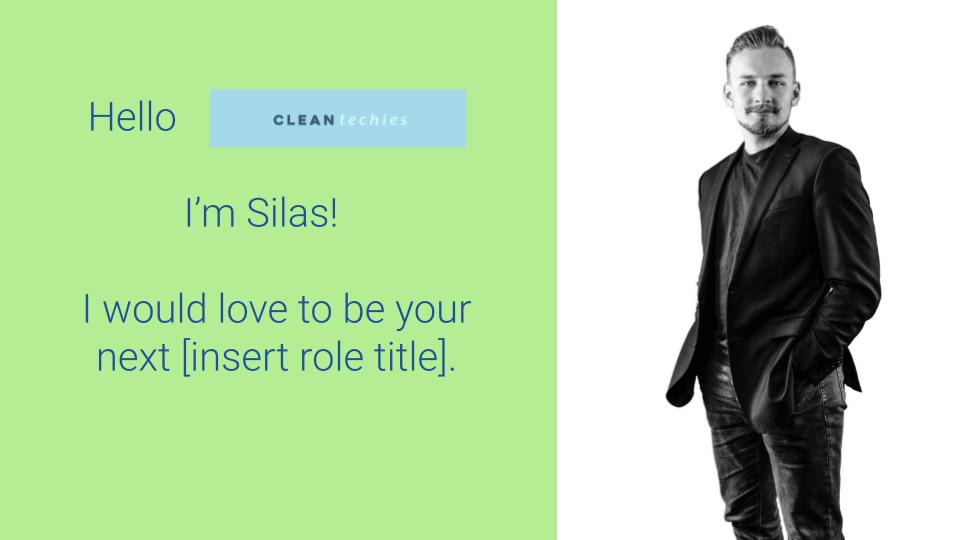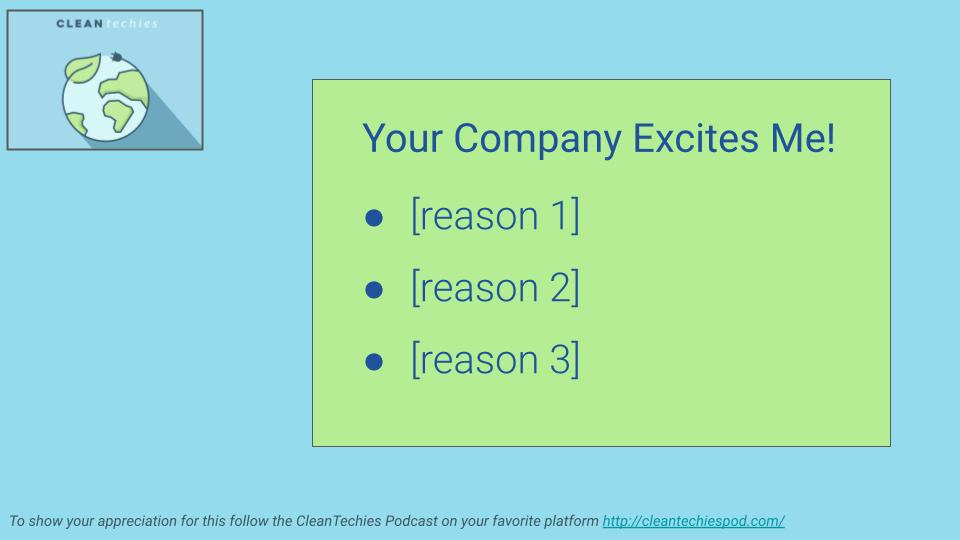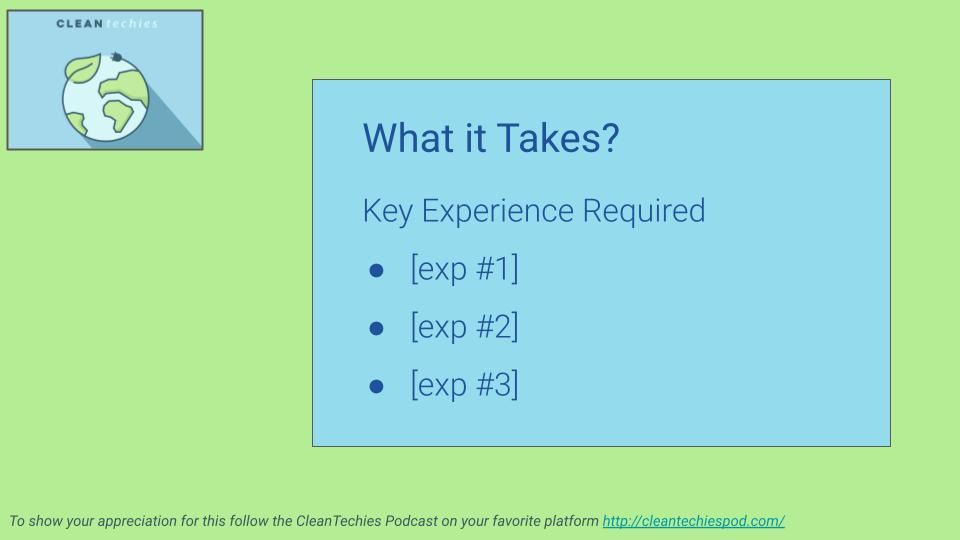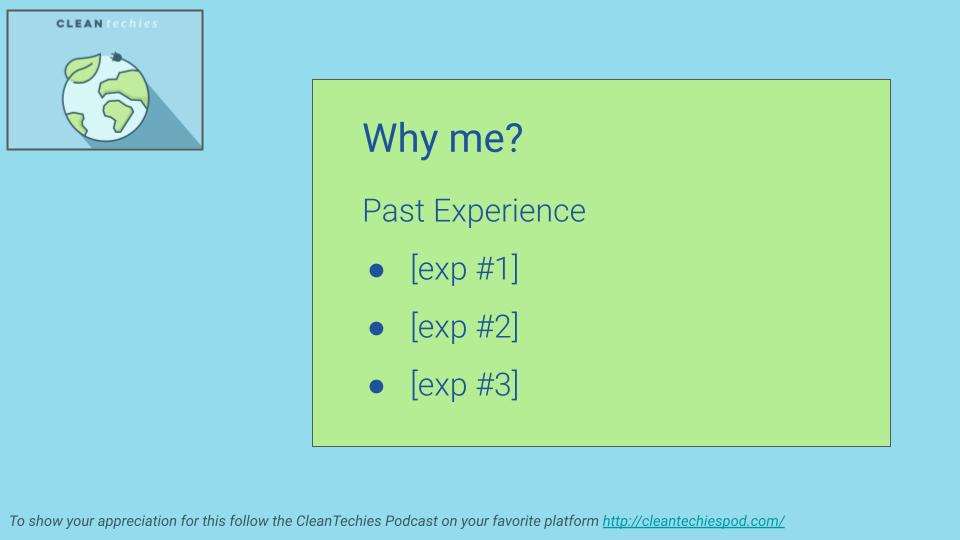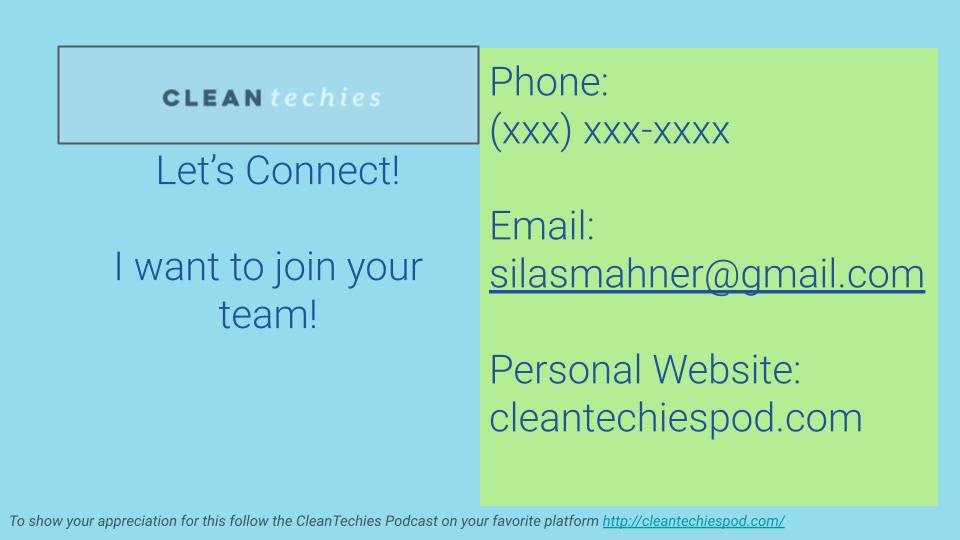How to Get a Job in ClimateTech
From the perspective of a ClimateTech Headhunter
As a headhunter in ClimateTech, I get approached by a lot of people asking me to help them get a job in ClimateTech. Some are recently laid off, some are genuinely interested in the space, some are recent graduates, and some are just trying to ride the wave of ClimateTech.
I often take a 15-minute call with these folks to give them my tips. This happens so often that I’ve decided to put it into a post and guide.
There is additional context at the bottom of this post if you’d like, but the meat and potatoes are right here.
🛑 Before you jump in, if you’re interested in learning what the leading investors and founders in climate say as advice on building and investing, subscribe to this publication. While this is a text post, we publish two episodes every week. One interview with an investor and one with a founder.
If you are a job seeker and would like a consultation with me, become a paid subscriber of this substack — by becoming a paid member, you get two 30-minute consultations with me to offer tailored strategies on landing your role in climate.
Step 1: Identify your market
ClimateTech is a very broad statement. There are loads of verticals in ClimateTech, so you need to narrow it down to one or two. Examples of verticals are Electric Vehicle Charging, Carbon Capture, Green Building Technology, Energy Tech, and Battery Recycling Technology. The list could go on for a while. If you’re not at all familiar check out this breakdown from ctvc.co.
In choosing your market/vertical, be realistic. Think about what you have done in the past or what you are doing now. If you focus on getting a green job in the same industry you’re already in, this is the easiest way to achieve your goal.
You can make a total change but be prepared to take a big pay cut.
Step 2: Find Ideal Companies
From here, you want to do some research and find the ideal companies you want to work for in that particular vertical. The best way to do this IMO is to go, again to ctvc.co and look through the capital providers. From here you get a little more narrow into what you want to do.
Go through the portfolio companies of each VC to identify between 10 to 20 of the companies you’re most excited to potentially work for. From these, start doing in-depth research about them, their tech, their founding team, and why they are cool to you.
Once you have done this, you’ll likely be left with 10-15 that you’re still super keen on. This leads us to the next step.
Step 3: Create a 5-Page Slide Deck
After you have in-depth research on each org, create a simple slide deck matching their branding with five slides. Here is a template that you can use to get started.
Slide 1: Intro & Interest
This slide should look something like this. Key points are, to use the brand colors of the company you’re pitching, use their font, and insert their logo. Having an image of you on there is helpful and more personal.
Slide 2: Why [X Company] Excites Me
This slide should demonstrate 3 to 4 key reasons why you’re actually interested in them as a company. Don’t make this generic. Make it something that truly matters to you. Even better if one of the points is something that took more than a surface-level skim of their website to learn.
Slide 3: Demonstrate Understanding
A huge mistake of many job applicants is not GENUINELY understanding the Job Description. Put yourself in the shoes of the hiring manager and company leadership. They have a very particular requisition. They need this person to do a specific job. They need that person, in most cases, to already have DEMONSTRABLE experience in that thing. If you do not understand the job description, then don’t bother applying.
After reading through and understanding the JD, try to boil it down to 3 or 4 key things that they are looking for. If you get close on this, it will win you big points with the hiring manager because you GET IT.
Slide 4: Why You
Here is where you pick 3-4 skills (matching those demonstrated on the previous slide) that you possess. These must be tangible. If a requirement is having run a GHG Accounting Project, and you’ve not ACTUALLY don’t that, you are not doing yourself a favor by saying you have.
Share a few things that you tangibly can bring to the table that correspond with the skills required slide.
Slide 5: Closing & Contact
This is a page with contact information and a call to action.
You can shake this up, of course, but keep it punchy.
Step 4: Record a Video of you Talking to This Deck
Yep. You heard that right. Change into your uncomfortable socks, and let’s make this happen.
This part is critical. The fact that it’s hard is what makes it valuable.
Your video will have a few key components.
Keep it short. Ideally, the pitch is less than 3 min. Longer is really hard to keep their attention.
Don’t script it. Unless you have years of acting experience and can remember lines, don’t bother trying to script it out. Understand and internalize each bullet point and the flow of each page.
Know what you’re saying and why you’re saying it. If you have that, you’ll be able to relay this information naturally, which feels like a conversation.Be sure your face is showing so they can get a feel for you.
Add personality to your voice. Demonstrate your interest through your tone of voice. Monotone is less likely to get you the desired outcome. Remember, most communication is beyond the words being said.
If you know for sure who the hiring manager is, use their name directly.
Here is a video where I walk through the components of each slide and then do an example run-through.
🛑 Is this valuable so far? Please share with a friend who can also benefit from it. ⏩
Want help implementing these tips? Become a paid supporter of this substack, and I’ll personally coach you on your job search, LinkedIn profile, and outreach strategy.
Step 5: Send to the Hiring Manager
Going through HR is often very difficult as they are much more by the book. It’s their job to be focused on governance. In any established company, HR is likely going to want everything standardized. So, for that reason, you’re best off going directly to the hiring manager.
Go through their LinkedIn or Website to find the person to who you’d report to. In many job postings, the hiring manager is named or implied. Put your research hat on.
When sending, make the email clear and concise with a good subject line.
An example might look like this.
Step 6: Follow Up
Send a follow-up email if you don’t hear back within 48 business hours. If you can, try to send something of value, like a link to a news article you thought they would find interesting (something related to the industry).
Follow up at least 8 times in various forms before giving up. Connect with them on LinkedIn. Engage with their posts on LI and Twitter. See if you can find a mutual connection who is willing to put in a word for you.
If after 8 tries, you don’t get through. Consider reaching out to someone else at the company.
That’s about it. Yes, it may seem like a lot of work, but this is likely to get you an interview. You will have a much higher hit rate than if you are spraying your CV to the world.
Speaking of effort, this post took some effort to make. If you’d like to show your gratitude, please follow the CleanTechies Podcast on your favorite platform, and if you can, consider supporting this publication financially with a paid subscription.
Context
If you’re interested in the context mentioned at the start of the post, here you go.
I’ve been a headhunter since March 2020 and have exclusively worked in the Climate, Renewables, and Sustainability space. I’ll let you in on a little recruiter secret. We only have jobs because most job applicants are total NPCs.
If people applied to jobs that they were actually close to qualified for, the number of headhunters in the world would be far fewer.
We are hired by companies to go out, find qualified candidates, convince them to take an interview (often, they are passively looking only), manage them through the interview process, and help close them on an offer. They pay us upwards of $25k per placement to do this. So, if you’re able to stand out in the job application process, you’re saving them a lot of money and putting me out of work.
Given the above, you might understand that headhunters work for their clients before they work for their candidates. Meaning that we won’t submit you to a job if you’re not what the person writing the checks is looking for.
The point of this context is really just to demonstrate that I’m familiar with this space and have been through the rodeo a few times.
Interested in a paid Climate Career Coaching Call with Silas? (Paid CleanTechies subscribers get 2 free per year)
If you're a software engineer wanting to work in climate, check out this resource/company list made by another software engineer: http://climatetechlist.com/
Thanks again for reading and your support for this page or the podcast, is greatly appreciated.
If you enjoyed this, please do reach out to me on Twitter to let me know. It means a lot! 🤟 🌍



